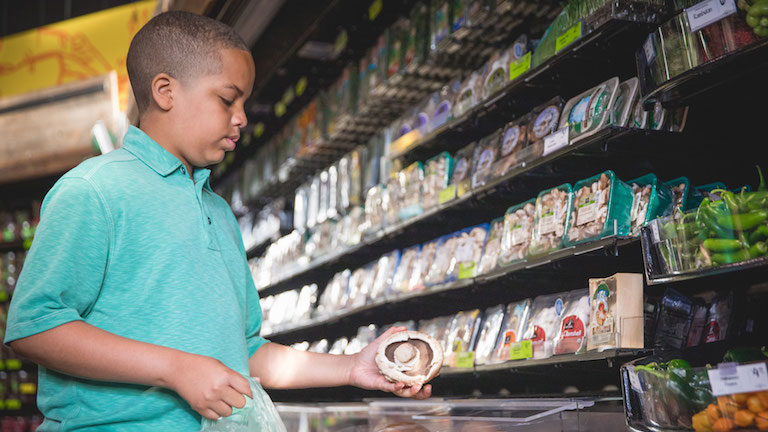 Schools
Schools
How to Bring Food Literacy to Your School or Childcare Center
Nutrition is not new to school curricula, but the introduction of food literacy education could expand students’ understanding of what it means to eat well. Not sure what food literacy is, or how you can begin implementing it in your school or childcare center? Read on to get your questions answered!
What is food literacy and why is it important?
The Food Literacy Center defines food literacy as “understanding the impact of your food choices on your health, the environment, and our economy.” [1]
Essentially, food literacy is an understanding of food that goes beyond its nutrient composition – it’s designed to help individuals, families, and communities make informed decisions about how they interact with food. This can translate to a knowledge of how to choose ingredients based on seasonality and local availability, the capability to prepare meals in different kitchen environments, or an understanding and sensitivity to the many ways in which culture and customs influence food choice.
This deeper connection to our food can encourage healthier habits too – you’ve likely heard the anecdote that students who grow their own food in a school garden are more likely to try (and like!) that food when it’s on their plates. One of the reasons for this is the experience students have while gardening – they’re not just learning about vegetables; they’re forming a connection with where food comes from, how it’s grown, and the time and energy that goes into producing the food we eat each day.
Food literacy education can produce similar effects and further teach today’s consumers that every decision we make around food impacts much more than our own bodies: our health (both individual and collective), environment, political culture, local and global economies are all influenced.
How is food literacy different than nutrition education?
Where nutrition education generally provides students with an understanding of food and its impact on their health from a scientific point of view, food literacy expands, and compliments, this lens.
Food-literacy related curriculum, for instance, might include: “(i) the food system from production to waste, (ii) the effect of food on health and wellbeing, (iii) the wider context of the food system including social, economic, cultural, environmental, and political factors, and (iv) the development of skills and behaviours related to food” [2].
How can you bring food literacy to your school?
Shifting food education may seem daunting, but there are many small yet significant ways to introduce food literacy concepts to students. Younger children respond well to functional and interactive activities that engage all of their senses (think cooking and sensory activities) whereas older students can build on this introductory knowledge with more applied concepts and skills [2].
The following are a few ideas for integrating food literacy concepts in the classroom and cafeteria.
- School gardens are a great way to educate students about food in new, hands-on ways. Consider starting small with container gardens, or utilizing a mushroom growing kit in the classroom to show students the growing process, without getting your hands dirty!
- Connect with local hunger relief organizations and invite them to speak to classes about food insecurity, the local food system, and how students can support food access for all.
- Organize field trips to local farms or food producers, for students to see our food system in action. If field trips prove difficult, bring the farm to the classroom, asking a farmer or representative from your produce distributor to speak to students about local agriculture, food production, and its impact on the local economy and environment.
- Review with older students the local or national policies around food, and their impact on our food choices, the local economy, and the environment. Identify opportunities for improving the food environment through policymaking, asking students to propose new policies and analyze the pros and cons of their proposals.
- Offer foods in the cafeteria, cooking demonstrations, and other events that reflect the local food culture. Invite students to share their families’ favorite food traditions and study the cultural, environmental, and physiological significance of foods eaten by our ancestors.
- Host experiential learning events for students in the classroom and cafeteria, where students can see, touch, taste, and smell a variety of foods.
Introducing Mushroom Madness: Food Literacy Lessons from Mushrooms in Schools!
Need a little help getting started? Mushrooms in Schools has created 3-lesson units highlighting the food literacy concepts of sustainability, nutrition, and cooking – all while introducing students to a variety of mushrooms! Here’s a summary of what each lesson covers:
Lesson 1: How Do Mushrooms Grow?
Students will learn how mushrooms are grown, their health benefits, and how they promote environmental sustainability.
Lesson 2: Classifying Mushrooms
Students will learn about the different types of mushrooms and will use the five senses to describe the characteristics and attributes of different mushrooms.
Lesson 3: Cooking with Mushrooms
Students will work together with the cafeteria staff to prepare a delicious mushroom avocado quesadilla recipe.
Lessons are divided into Pre-K, Grades K-2, and Grades 3-5, and both our K-2 and 3-5 lessons are aligned with Common Core standards.
We invite you to explore and download these free lesson plans at https://www.mushroomcouncil.org/school-nutrition/classroom-education/.
References:
[1] We inspire kids to eat their vegetables. (n.d.). Retrieved from https://www.foodliteracycenter.org/
[2] Nanayakkara, J., Margerison, C., & Worsley, A. (2018). Senior Secondary School Food Literacy Education: Importance, Challenges, and Ways of Improving. Nutrients, 10(9), 1316. https://doi.org/10.3390/nu10091316


We collect, use and process your data according to our Privacy Policy.